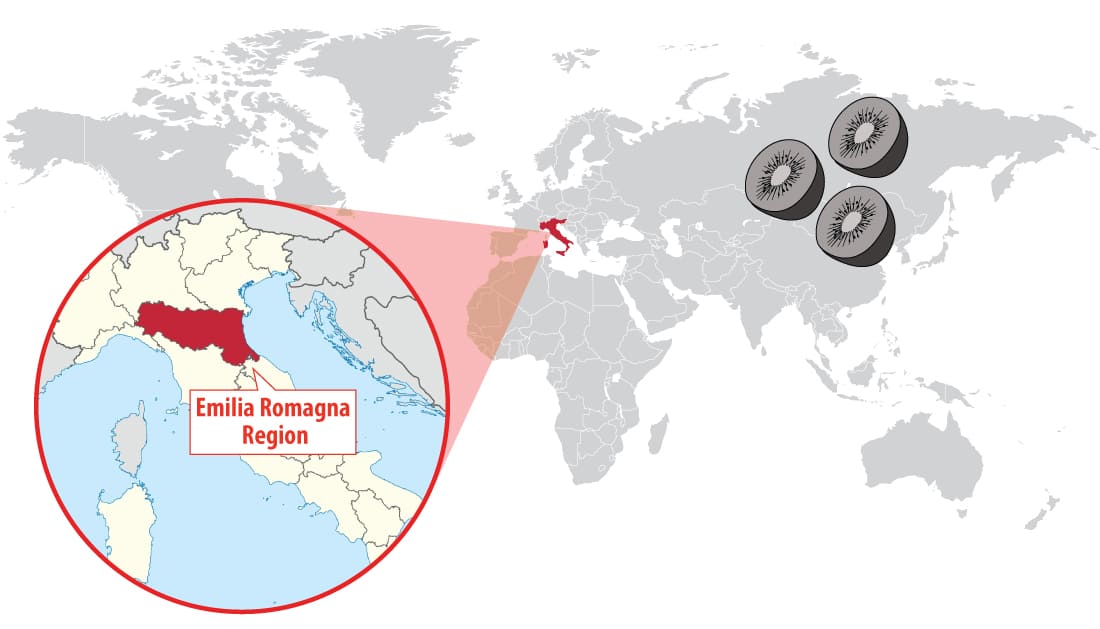Smart irrigation system to improve kiwi production in Italy
Italy is the second major kiwi producer after China with a saleable production around 448.000 tonnes last year. Both countries with New Zealand, Chile and Greece suppose the 93% of worldwide production by a research of the Centro Servizi Ortofrutticoli (CSO).
The CSO informed in 2015 that the grow surface for kiwi on the Mediterranean country was 24.440 ha, most of them in the regions of Lazio, Pedemont and Emilia Romagna.
Emilia Romagna Region (Italy)
FAMOSA is an Italian company that works on technology-based support for agriculture, offering solutions for crop monitoring and management. They have developed wireless sensor networks, based on Libelium technology, in a kiwi plantation with GPRS and Sigfox to develop accurate irrigation strategies for farmers.
Comparing GPRS to Sigfox
Kiwifruit is one of the most sensitive fruits in terms of quality which is given by size, sweetness and dry matter. In order to reach the best quality, the Rivista di Frutticoltura e di Ortofloricoltura considers that it is essential for farmers to develop a good irrigation strategy to attain marketable products and to reduce product losses.
Agriculture organizations are deploying cutting-edge technologies in their plantations to improve processes, to maintain high quality standards and to ease farmers daily works. “We have chosen Libelium Waspmote Plug & Sense! Sensor Platform for its wide range of sensors and the easy development of software for data acquisition and transmission”, has stated Massimo Noferini, CEO of FAMOSA.
Waspmote Plug & Sense! installed in kiwi plantation
For this project, the company has installed two different wireless sensors to monitor soil water status to plan irrigation in a kiwi orchard. Data has been recorded with the same system but information has been transmitted to the platform by two different wireless connection: GPRS and Sigfox. The main aim has been testing reliability and costs during 2016 kiwi growing season.
Two Waspmote Plug & Sense! Smart Agriculture have been deployed with watermark sensors in different depths to control soil moisture with fruit diameter sensor to measure the size of the fruit; and temperature and humidity sensors to monitor environmental conditions. One of the sensor platforms is connected to a GPRS shield and the other with Sigfox.
The first one represents the classical widely used data communication network and the second one the rapidly diffusing LPWAN technologies.
The information collected by the sensors has been sent to esiFARM, FAMOSA’s platform, that includes both GPRS and Sigfox technologies. To manage GPRS stations however a server has had to be configured. In this case Meshlium IoT Gateway has been used embedding Meshlium Management System making data handling easier. Farmers can get valuable information to schedule irrigation timing to avoid stress conditions, which is fundamental on kiwi plants.
Functioning diagram of the FAMOSA deployment
FAMOSA has detected some differences between both technologies after the deployment:
- GPRS:
- A server is needed to host data that has to be maintained by the local services.
- There must be GPRS/3G/4G coverage.
- It is needed power consumption hardware because GPRS node requires a long-duration battery pack or external power supply. The hardware needs to stay awake for a long-time and requires a longer communication session.
- It needs a SIM card that usually takes some days to be activated. Even if international SIM cards are available, there is a strong dependence to a contract which make connections liable to changes and reliability.
- Sigfox:
- It dumps data to a unique service which is accessible worldwide: data can be managed autonomously or by an intermediate service.
- Coverage is already diffused in Italy so it is not available everywhere although it is rapidly growing worldwide.
- It doesn’t need a handshake step with the network, while based on an acknowledge response.
- Communication is very short and allows the device to stay dormant for a long time allowing a much longer duration to batteries.
- Registration is quicker than GPRS, based on an annual fee.
Fruit diameter sensor
The final user has not been aware nor suffered the difference between the communication through GPRS or Sigfox. Battery pack proved to have a life long enough to cover the season both in Sigfox and GPRS devices. In general, any field deployment should be as simple as possible and have a ready and reliable answer during installation tests.
Precision Farming to make smart irrigation decisions
Developing technological projects in rural areas may involve several difficulties because of the absence of physical communication infrastructures and the costs which are often unaffordable. However, wireless sensor networks suppose a great opportunity because of the low installation, maintenance and also operative costs.
esiFARM platform
FAMOSA is collaborating with farmers to introduce the IoT approach with esiFARM in their fields. The platform allows to collect information from the sensor platforms and other information sources such as georeferenced cameras pictures or multispectral analysis of satellite imagery. EsiFARM includes models to help farmers in decision and alerts (irrigation, pathogens and maturation).
“Farmers were impressed by the ease of the installation, which proved to be able to give real-time and comprehensive information in less than one hour of full installation”, has argued Massimo Noferini, CEO of FAMOSA. During 2016 season between March and October the decision support system has worked well and continuously.
Farmers have been able to monitor without interruptions soil water status to have irrigation always under control.
Kiwi crops in Emilia Romagna
The deployment of soil water status sensors at different depths has allowed to compare the effect of irrigation strategies. Farmers have had a prompt warning about any water stress condition to recover from a growth deficit. In this kiwi project, the irrigation system was activated by the farmer.







Comentários
Enviar um comentário